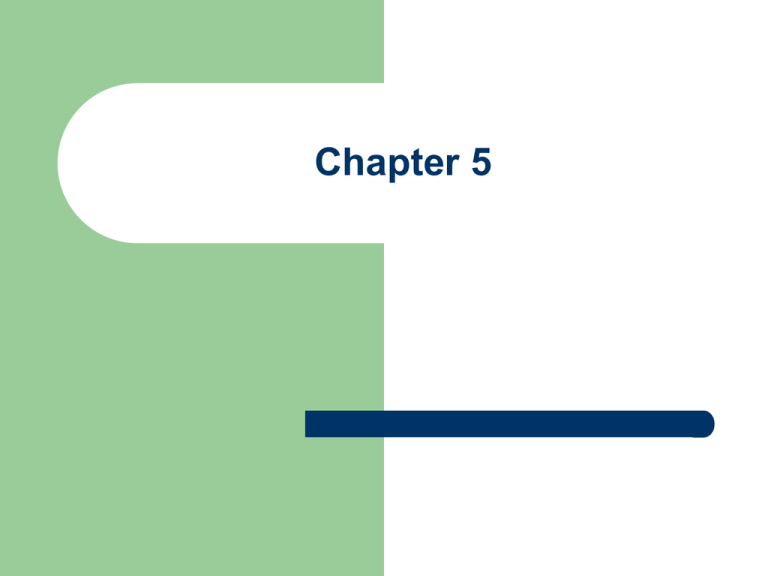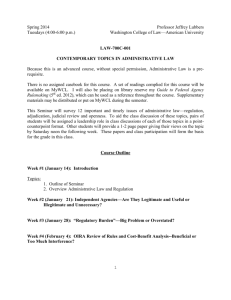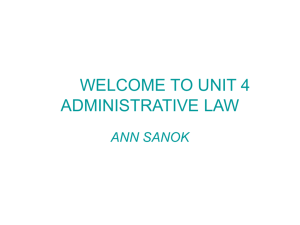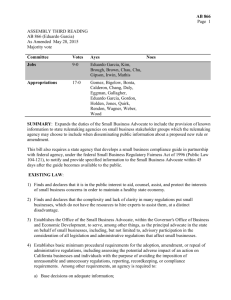Update Slides for the remainder of Chapter 5
advertisement

Chapter 5 Quick Review Chapter 2 – Chapter 3 – 2 Hearing basics Chapter 4 – When do you get a hearing? Hearing Procedure These chapters deal with the agency acting as a court Rulemaking 3 Chapter 5 deals with the agency acting as a legislature The shift from adjudications to rulemaking started in the 1950s The courts try to allow an agency to make rules Parallels the growth of state and federal agencies The Federal Register and LA Register are where rules are published first Rules are Codified in Code of Federal Regulation and the LA Administrative Code Participation and Generality Allows Public Participation – Political input – Rulemaking is a public process which allows politicians input Appropriate Procedure – – 4 Adjudications are limited to the parties Adjudications are tied to specific facts and parties Rules are generally applicable, although they may be very specific Prospective v. Retrospective Retroactivity – – – Rules are prospective – 5 Adjudications are like trials in that they are based on things that have already happened Adjudications can be treated as treated as precedent, but this is not binding Adjudications are driven by the available cases Not bound by existing facts Uniformity 6 Adjudications, like trials, are driven by specific facts and can treat similar situations differently Rules set up a general framework that treats all parties uniformly Rules are the fairest way to make big regulatory changes Agency Efficiency 7 While a rulemaking can be expensive and time consuming, it can settle issues across a large number of adjudications Remember the disability cases where rulemaking was used to narrow the scope of adjudications? Rulemaking can also eliminate many hearings by resolving factual questions Better Guidance for the Public Rules are published and codified – Agency adjudications, especially at the state level, are often not published – 8 State rules were hard to find, but the Internet is making this better There may be no transcript of the full adjudication Agency Oversight 9 You can control the outcome of rulemaking much easier than that of adjudication Not Dependant on ALJs More input from across the agency Directly controlled by agency policy makers Why is this especially important in LA? Downside of Rulemaking 10 Adjudications can be more flexible in the individual cases Rules can be so abstract or overbroad that they are expensive or difficult to follow Adjudications are useful when you are not sure what the rule should be and need more info and a chance to experiment Does not do away with the need for adjudications Rulemaking Ossification Rulemaking has gotten so complex and time consuming it has lost some of its value Rulemaking can go on for years – – 11 What is the legal value of a proposed rule that has not been finalized? This was the problem for the anti-kickback regulations Due to regulatory conflict and incompetent agency practice The courts and legislature have increased the burden on rulemaking Definition of a Rule 12 4) 'rule' means the whole or a part of an agency statement of general or particular applicability and future effect designed to implement, interpret, or prescribe law or policy or describing the organization, procedure, or practice requirements of an agency and includes the approval or prescription for the future of rates, wages, corporate or financial structures or reorganizations thereof, prices, facilities, appliances, services or allowances therefor or of valuations, costs, or accounting, or practices bearing on any of the foregoing; APA 551(4) Not a clear definition Things that are not adjudications or licensing State Definitions 13 Critical term is general applicability Remember London and Bimetalic? Remember the standards for a hearing? If you do not get a hearing, it is probably a rule We will review the LA standards when we finish this chapter Interpretive Guidance Critical distinction – – – 14 Does not need notice and comment It is only explaining the law Prosecution guidelines are classic examples Can be a really fine distinction when the underlying law is vague Very specific laws - like the ADA - leave no room for rules so everything is a guideline Probably the biggest benefit of the Internet is putting these online Prospectivity and Retroactivity Legislation is often retroactive - ask anyone hit under superfund Rules are not supposed to be retroactive, but what does that mean? – – 15 I cannot go back and say that you can no longer get paid for in office chemotheraphy and then ask for a refund I can say you can no longer get paid for in office chemo and make your investment in your stand alone cancer center worthless Only real limit is ex post facto provision in the Constitution Bowen v. Georgetown University Hospital 16 Feds change the way reimbursement is calculated on Medicare costs What was the retroactive effect of this rule? Did the court accept this? What if the "conditions of participation" says that you are subject to retrospective rule changes which require refunds? The court in a later case found that there could be changes in the way that base year calculations were done, even though these changed past bills What about Interpretative Guidance? 17 Why does this ban on retroactive rules not apply to interpretive rules? How is this like the court system when a judge finds a new tort cause of action? Could congress create an exception to the APA and allow a retrospective rule? Chocolate Manufacturers Ass’n v. Block What did Congress tell the agency to do that resulted in these regs? – What did the proposed rule address? What about fruit juice? – 18 Congress wanted the agency to quit using WIC funds for junk food Agency proposed a rule that said sugar was bad in the preamble, including the problem with juice, and then proposed limits on sugar in cereals How was the final rule different from the proposed rule? – Final rule said no more flavored milk The Notice Problem What was the CMA's claim? What was the agency defense? – – Does the rule have to be the same? – – – 19 Lots of commenters said chocolate milk is bad HIPAA problem - paper or electronic? Why have notice and comment then? What is the logical outgrowth test? How would you use it in this case? What did the court order in this case? What will the CMA do? How Much Info in the Rule? How is United Steelworkers different from CMA? – – 20 OSHA proposed a rule that said it was considering requiring that employees removed from the workplace for toxic exposures get a Medical Removal Protection (MRP) that could include full pay and benefits, but did not specific the proposed MRP Court said that was enough because it put everyone on notice of the possible range of rules What about Technical Information? What did the court require in Portland Cement v. Ruckelshaus, 486 F2d 375 (1973) – What about Connecticut Light and Power v. NRC, 673 F2d 525 (1982)? – 21 The agency must disclose the factual basis for the proposed rule, if it relied on scientific studies or other collections of information The agency cannot play hide the peanut with technical information Why is this a big deal in environmental regs? What are the potential downsides of this policy? – Circular A-110 Subsequent additions to the record Rybachek v EPA – – Idaho Farm – – 22 EPA added 6000 pages of supporting info Court said the agency may supplement the rulemaking record in response to comments asking for explanation Agency added a report to record, then relied on it in the final rule. The agency may not add new material and then rely on it without given an opportunity to comment on it. Must the agency allow oral testimony? Can be limited to written comments Why do agencies sometimes have hearings to allow oral comment? – – – – What about those without resources? – 23 Enhances citizen participation Allows politicians to grandstand Can be good to get publicity Avoid it if you plan on going against public sentiment. Sometimes the agency will provide support and even legal fees encourage participation Formal Rulemaking Just like formal adjudications – – Must have magic language – 24 Very time consuming and expensive Courts try to avoid making agencies do it Only when rules are required by statute to be made on the record after opportunity for an agency hearing Why avoid formal rulemaking? What happened in the peanut hearings? – – What was the concern in Shell Oil v. FPC? – 25 Should peanut butter have 87 or 90% peanuts? 10 years and 7,736 pages of transcript Formal rulemaking was impossibly time consuming to use for regulating something changeable such as natural gas rates. Why does just getting the right to be heard at a formal hearing benefit parties that oppose a rule? Remember - if you oppose a rule, you have an interest in tying up the hearing Hybrid Rulemaking 26 A lot of this arose from the environmental activism that lead to the first and subsequent Earth Days. Congress wanted to allow citizens and communities to participate in significant regulatory issues that were seen as public policy debates. In many cases this was a problem because the agency was given a law that had specific technical requirements that did not include public policy issues. Courts then began debating their role in reviewing these proceedings Was it strictly procedural, with deference to the agency? Should they do a substantive review? Vermont Yankee v. NRDC, 435 US 519 (1978) 27 How did the agency justify using rulemaking to to decide on the disposal of spent fuel? What did the agency say should be done with it? The AEC relied on an expert’s report – what did the plaintiffs want to do? Is this normally allowed in rulemaking? Why did the DC court claim it was remanding? How did the United States Supreme Court say APA 553 limited the DCC’s review? Followed, but the courts find ways around it. Also applied to adjudications Role of Agency Heads Morgan I found that agency heads to have some familiarity with adjudications they approve Should this apply to rulemakings? Problem – – – – 28 FDA chief signs a zillion new regs within a week after taking office Can you challenge them because he could not have know about them? How would you have to prove it? What do you have to show to get the deposition? Ex Parte Communications and Political Influence in Rulemaking Why is the ex parte problem different in rule making than in adjudication? Do ex parte contacts matter in rule making? – Home Box Office, Inc. v. FCC – – Regulation of advertising and program content on cable Lots of contacts with FCC commissioners Court says it is a big problem if info is left out of the record – – 29 Traditional view - rulemaking is open to all, so there are no ex parte contacts You do not need to put in stuff that happens before the rule is promulgated Decisionmakers should not talk to outsiders during the review period after publication, and should document it if they do. Sierra Club v. Costle 30 Sierra Club claimed senator Bird coerced the EPA on coal burning power plant standards Why would Senator Bird care about this? What should Congress do if it does not like ex parte contacts in rulemaking? What is the key test when looking at the record? When everything is done, the record must support the rule, so if ex parte contacts were critical to the rule they must be documented What is the president's role in rulemaking? Controls and supervises executive branch decisionmaking How is the role different in adjudications? When should the the president's contacts be documented? – – – 31 When they involve an adjudication When the statute requires that they be docketed If the rule is based on factual information that comes from such a meeting. Applying the Volpe Test in Sierra Club v. Costle The Volpe test for whether a rulemaking may be overturned solely on evidence of Congressional pressure – – What did the court rule when it applied these to this case? – – 32 1) was there specific pressure on the agency to consider improper factors? 2) did the agency in fact change its mind because of these considerations? No problem with the contacts because Congress should be involved in such policy decisions What if Byrd said he could cut off funding to the agency and get everyone fired? Bias and Prejudgment Remember the cases on bias of decisionmakers in adjudications? Should these also apply to rulemaking? Association of National Advertisers , Inc. v. Federal Trade Commission – – – What happened in Cinderella? – 33 FTC is adopting rules on TV advertising directed at children Chairman has written and spoken at length on the evils of TV ads aimed at children Plaintiffs seek to disqualify him because of bias Cinderella which disqualified the same Chairman from participating in an adjudication because he had prejudged some of the facts. What is the standard for disqualifying the decisionmaker in a rulemaking? Clear and convincing evidence that he has an unalterably closed mind on matters critical to the rulemaking. How did the district court attempt to disqualify the chairman? – – Rejected because modifications of rulemaking procedures do not make them adjudications How did the court characterize the Commissioner's comments? – Discussion and advocacy What is it going to take to disqualify an agency head from a rulemaking? – 34 Said there were aspects of an adjudication to this rule making because there was a limited statutory right of cross examination The court had to find the rule supported by substantial evidence Charlton Heston as head of BATF? § 5.6 Findings and Reasons Why Publish Findings and Reasons? 36 Facilitates meaningful judicial review of agency action The exposition requirement subjects the agency, its decisionmaking processes, and its decisions to more informed scrutiny by the Legislature, the regulated public, lobbying and public interest groups, the media, and the citizenry at large. Requiring an administrative agency to articulate publicly its reasons for adopting a particular order, rule, regulation, or policy induces agency action that is reasonable, rather than arbitrary, capricious, or lacking in evidentiary support. The agency introduces an element of predictability into the administrative process. This enables the regulated public to anticipate agency action and to shape its conduct accordingly. It stimulates public confidence in agency action by promoting both the reality and the appearance of rational decisionmaking in government. The Burden of Publishing How are state agencies different from federal agencies? – – – 37 Limited staff Greater reliance on the expertise of board members Board may hear lots of testimony and review a lot of info they cannot afford the time and effort to put together volumes of supporting info for regs Should state agencies have a reduced publication requirement? Should they be able to publish rules without explanation? § 5.7 Issuance and Publication 38 This section deals with the publication of information, separate from the notice and comment process. As previously discussed, interpretative guidelines and other documents that only explain the law do not have to be published, but the difficulty is determining the classification of the document. As you read this section, think about how electronic communications is changing this area. What was story in the Panama Refining case that lead to the Federal Register Act? How often is the FR published? What are the five classes of information that 552(a)(1) requires to be published? 39 (A) descriptions of its central and field organization and the established places at which, the employees (and in the case of a uniformed service, the members) from whom, and the methods whereby, the public may obtain information, make submittals or requests, or obtain decisions; (B) statements of the general course and method by which its functions are channeled and determined, including the nature and requirements of all formal and informal procedures available; (C) rules of procedure, descriptions of forms available or the places at which forms may be obtained, and instructions as to the scope and contents of all papers, reports, or examinations; (D) substantive rules of general applicability adopted as authorized by law, and statements of general policy or interpretations of general applicability formulated and adopted by the agency; and (E) each amendment, revision, or repeal of the foregoing. What is the legal effect of materials that are not published but are covered by this provision of the APA? Nguyen v. United States 40 What business is this? What law is being violated? Was plaintiff on notice of the violations? How many chances does the agency give before sanctions? Was this published? Nguyen - The Litigation 41 What is plaintiff's claim? What did the lower court do? What is the standard of 552(a)(1)(D)? What is the circuit court's test? Did the court find that the rule should have been published and why? The Court's Factors in Nguyen 42 1) does it change existing rules, policy or practices? 2) does it deviate from the plain meaning of the statute? 3) is it of binding force and does it narrowly limit administrative discretion? Does this get plaintiff off the hook? What is the reliance issue? Non-Legislative Rules (Guidelines) 43 Do these have to be made available to the public? Do they have to be published in the FR? Key issue - how might this be modified if the agency puts the rules on the WWW? Emergency Rules What provision of the APA allows for emergency rules? 553(d)(3) – – What non-emergency rules do not have to wait 30 days and why? – – 44 (d) The required publication or service of a substantive rule shall be made not less than 30 days before its effective date, except (3) as otherwise provided by the agency for good cause found and published with the rule. Those that grant an exemption or remove a restriction They do not adversely affect any parties. § 5.8 Regulatory Analysis 45 How is regulatory analysis different from notice and comment rulemaking? What is CBA? Why is CBA sometimes very controversial, especially for environmental regulations? What is the value of regulatory analysis? Executive Orders 46 What is an executive order? How were they used after 9/11? What about on Westwing? Do they require notice and comment? OMB - Office of Management and Budget OIRA - Office of Information and Regulatory Affairs Executive Order 12866 - Regulatory Planning and Review 47 OIRA must review rules that have an impact of more than 100M aggregate or substantial impact on a segment of the economy or any thing else. The Regulatory Philosophy Federal agencies should promulgate only such regulations as are required by law, are necessary to interpret the law, or are made necessary by compelling public need, such as material failures of private markets to protect or improve the health and safety of the public, the environment, or the well-being of the American people. In deciding whether and how to regulate, agencies should assess all costs and benefits of available regulatory alternatives, including the alternative of not regulating. CBA under 12866 48 Costs and benefits shall be understood to include both quantifiable measures (to the fullest extent that these can be usefully estimated) and qualitative measures of costs and benefits that are difficult to quantify, but nevertheless essential to consider. Further, in choosing among alternative regulatory approaches, agencies should select those approaches that maximize net benefits (including potential economic, environmental, public health and safety, and other advantages; distributive impacts; and equity), unless a statute requires another regulatory approach. What must the agency provide OIRA for regs that are covered by 12866 - I 49 An assessment, including the underlying analysis, of benefits anticipated from the regulatory action (such as, but not limited to, the promotion of the efficient functioning of the economy and private markets, the enhancement of health and safety, the protection of the natural environment, and the elimination or reduction of discrimination or bias) together with, to the extent feasible, a quantification of those benefits; What must the agency provide OIRA for regs that are covered by 12866 - II 50 An assessment, including the underlying analysis, of costs anticipated from the regulatory action (such as, but not limited to, the direct cost both to the government in administering the regulation and to businesses and others in complying with the regulation, and any adverse effects on the efficient functioning of the economy, private markets (including productivity, employment, and competitiveness), health, safety, and the natural environment), together with, to the extent feasible, a quantification of those costs; What must the agency provide OIRA for regs that are covered by 12866 - III 51 An assessment, including the underlying analysis, of costs and benefits of potentially effective and reasonably feasible alternatives to the planned regulation, identified by the agencies or the public (including improving the current regulation and reasonably viable nonregulatory actions), and an explanation why the planned regulatory action is preferable to the identified potential alternatives. What are the potential effects on agencies of these mandates? How can the president do this without legislation? Cost-benefit and Risk-benefit analysis 52 What is Justice Breyer's tunnel vision problem? What was his environmental law example and why does it matter? What about asbestos and brown fields? What are areas where CBA can have adverse effects? Do the costs and benefits always fall on the same group? How does the diffuse and long term nature of benefits complicate CBA? Should we use CBA for health regulations? 12866 and Rulemaking 53 How is 12866 CBA incorporated into rulemaking? What if the statute says no CBA - can the president impose it anyway? Why is there a special provision for analyzing impact on small businesses? Unfunded Mandates 54 What is an unfunded mandate? How is this stealth regulatory reform? Unfunded Mandates Act of 1995 - Agency must do a CBA if the costs exceed 100M What would be the impact of banning unfunded mandates? What are the types and impact of unfunded mandates on public schools? Negotiated Rulemaking 55 What is reg-neg? How do you set it up? Why do it? Do you still have to do notice and comment? How does notice and comment prevent the agency from being bound by reg-neg agreements? What is the representation problem in reg-neg? Who got left out in the woodstove reg-neg? Why? End of the chapter! 56






